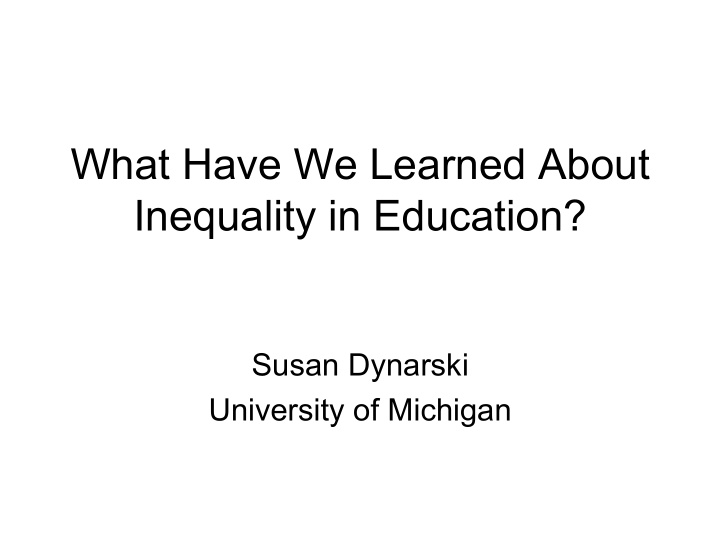



What Have We Learned About Inequality in Education? Susan Dynarski University of Michigan
Trends and Inequality in Educational Attainment
Rising Postsecondary Attainment 2 Source: US Census, from Bailey & Dynarski (2011)
Differences by Sex: Any College Female advantage today 2-3x as large as historical male advantage ever was 3 Source: Bailey & Dynarski (2011)
Differences by Sex: BA completion Male BA completion stagnant for 30 years 4 Source: Bailey & Dynarski (2011)
Differences by Income: Any College 5 Source: NLSY, from Bailey & Dynarski (2011)
Differences by Income: BA 6 Source: NLSY, from Bailey & Dynarski (2011)
PSID Tells Similar Story 7 Source: Duncan, Kalil, and Ziol-Guest (2015)
Tax Data Tell Similar Story Source: graphic from New York Times June 2, 2015. Based on Bailey & Dynarski 8 2011; Chetty et al 2014.
Some Candidate Explanations 1. Academic Preparation 2. Financial Barriers 3. Institutional & Other Barriers 9
Academic Preparation
BA by Income & 10 th Grade Math 11
Share Low SES in Top Score Quartile: 10% Share High SES in Top Score Quartile: 48% 12
Differences by Income: 8 th Grade Scores (2006) 13 Source: Reardon (2011)
14
15
Financial Barriers
17 SOURCE: The College Board, Trends in College Pricing 2012.
Aid Reduces Costs 18 SOURCE: The College Board, Trends in Student Aid 2014.
Sources: NPR Planet Money graphic based on data from College Board, Trends in College Pricing
Sources: NPR Planet Money graphic based on data from College Board, Trends in College Pricing
Net Prices by Parents’ Income: Public, 2-Year Colleges 21 Source: Trends in College Pricing, College Board . Income quartiles defined among college students.
Net Prices by Parents’ Income: Public, 4-Year Colleges 22 Source: Trends in College Pricing, College Board . Income quartiles defined among college students.
Effect of Cost on Attainment • Quasi-experimental studies find that when prices decrease, enrollment increases • 3-5 percentage point increase in enrollment per $1,000 in grant aid • Evidence of effects of grant aid on degree completion less conclusive 23 Source: Dynarski & Scott-Clayton (2013).
Institutional & Other Barriers
Complexity in College Funding • Funding system in US is extremely complicated – Huge variation in tuition prices – Dozens of aid programs • Widespread misinformation about net price of college – Overestimates of tuition prices – Underestimates of aid 25
Aid Application
Effect of Complexity • Randomized trial tested effect of completing aid application for low-income families – Bettinger, et al (2012) • Boosted college attendance 8 pp – Effects persisted for three years of college • Information intervention: zero effect 30
Institutional Barriers • Low-income students have high aspirations, throughout high school • Even academically-prepared students fail to go to and attend college • Tend to fall off track when hitting administrative hurdles – Completing aid forms – Completing applications, essays 31
Cheap: Nudges • Text students to remind to complete forms – Series of papers by Castleman and Page – 7 point increase in attendance • Texts and phone calls to coach college students – Bettinger and Baker (2014) – Increases in retention Summary of studies and links at Dynarski, New York Times, Jan 18, 2015 32
Not Cheap: Advising and Student Support • City University of New York (CUNY) tested effects of “wraparound services” at community college for low-income students – Intensive advising – Free text books & metro card – Priority registration • Randomized trial, run by MDRC: Doubled share graduating with AA Summary of study and links at Dynarski, New York Times, March 12, 2015 33
Bottom Line • No single, magic bullet can eliminate inequality in educational attainment • Lots of small and large steps – Boost academic achievement before college – Reduce college costs – Support students through hurdles during postsecondary transition – Intensive supports during college 34
Recommend
More recommend